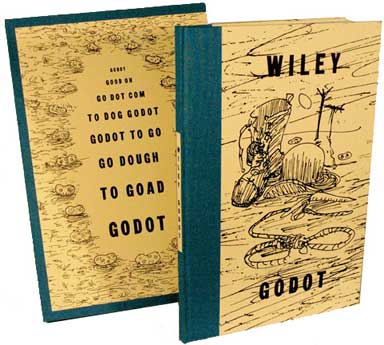Godot
Godot
An imaginary staging by William T. Wiley of "Waiting for Godot" by Samuel Beckett, with an introduction by David Littlejohn, program note and synopsis by Andrew Hoyem, and an afterword by William T. Wiley, signed, 2006. $800.00. Out of print.
Publication 77
This book is published in 2006 in honor of the hundredth anniversary of the birth of Samuel Beckett. It is not the play Waiting for Godot. It is a book about the play: a critic’s appreciation, fifty colored prints inspired by the play, a synopsis of the drama, and an artist’s comments. There are two other prints, in black only: a frontispiece portrait of the playwright and an explosive tailpiece. The synopsis is only a guide. It can be read for relevance to the images or their irrelevance and irreverence. For the play, go to the theater. For Beckett’s words, read the script in his original French and/or in his English translation. For that purpose this artist book is accompanied by the bilingual hardcover trade edition published by Grove Press.
Wiley is a punster and apologetic for his affliction. His puns are visual and verbal. The characters appear as human actors in bum’s clothing; they are also represented as hourglass figures. Time is running out. At the bottom of the hourglass is an ampersand (&). The sign for “and” stands for the “sand” running through the hourglass. Time, as an hourglass sunk in a sandbox, is an “embedded reporter”. The hangman’s noose that dangles from a branch becomes a serpent entwining the tree. Beckett has a pair of boots, heels together, pointing out, front and center stage, at the beginning of the second act, but Wiley has them toe-to-toe, as if facing off, confrontationally. Godot becomes Good Dough, becomes a Goad (from another Beckett play, Act Without Words II) to the artist and to us as witnesses. In the Afterword Wiley tells how he was first exposed to Beckett’s dramatic works through a performance in San Francisco of that play in the early 1960s and how differently he responds to Waiting for Godot as a reader and seer than as a playgoer.
FORMAT
The book was designed by the publisher Andrew Hoyem, who also provided the Program Note that appears before the curtain rises on this staging-on-the-page and the synopsis of the play that runs in five-line segments beneath the Wiley prints. The format is folio, 15 by 10 inches. The volume is 68 pages. The type is Century Expanded, in Monotype composition for 12 point, in hand composition for 18 point and larger sizes. The prints are made from photopolymer plates, three for each: the black line and the blue and yellow tints. The paper is mouldmade Hahnemühle linen. The binding and slipcase have blue cloth spines and yellow paper sides and labels, imprinted with titling and images by Wiley. The wordplay on the slipcase includes the palindrome “To Dog Godot” and is surrounded by a field of Irish potatoes. The edition is limited to 300 numbered copies for sale and 26 lettered copies for complimentary distribution to participants, each signed by the artist. The price of $800 includes a copy of En attendant / Waiting for Godotby Samuel Beckett, published by Grove Press. Published December, 2006. The book is sold only with one of 50 unique, hand-colored Wiley prints. The combined price of the book and print is $1,500. Out of print.
Share

